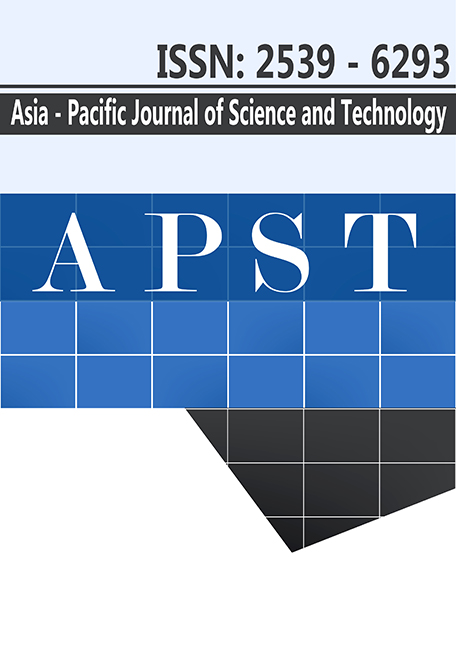Safe job rotation scheduling with minimum setup time
Main Article Content
Abstract
Workforce scheduling can be a challenging task especially for heavy industries, where workers are regularly exposed to excessive indoor noise levels of a harsh work environment. Repetitive exposure to loud noise can lead to hearing loss. In some situations, job rotation is a necessary measure for reducing the daily noise exposure among workers. However, excessive rotation of workers can result in an unnecessary loss of productivity and work flow continuity, due to the time required for machine setup and transferring workers between workstations. This study uses mathematical modeling techniques to design job rotation schedules. The goal is to control and limit the daily noise exposure levels of workers to a safe level of 90 dBA, while minimizing the total setup time caused by job rotation. A case study of a metal container manufacturing plant in Thailand is presented to illustrate application of the proposed model in a realistic situation. At first, this study determined the optimal workforce schedule with a minimum number of workers required to process tasks. Then, an additional worker was added to the workforce to reduce the need to rotate workers, resulting in less setup time and lower productivity loss. This was repeated until the productivity loss due to setup could not be reduced further. When labor and productivity loss costs are known, planners are able to select the most desirable job rotation schedule.
Article Details
References
[2] Ologe, F.E., Olajide, T.G., Nwawolo, C.C., Oyejola, B.A., 2008. Deterioration of noise-induced hearing loss among bottling factory workers. The Journal of Laryngology & amp; Otology 122, 786–794.
[3] S. A. Anjorin, A. O. J. A. T. C., 2015. Evaluation of industrial noise: a case study of two Nigerian industries. European Journal of engineering and technology 3, 1-16.
[4] Bedi, R., 2006. Evaluation of occupational environment in two textile plants in northern India with specific reference to noise. Industrial health 44, 112-116.
[5] NIOSH 1996. Preventing Occupational Hearing Loss - A Practical Guide. DHHS (NIOSH) Publication Number, 96-110.
[6] Rissén, D., Melin, B., Sandsjö, L., Dohns, I., Lundberg, U., 2002. Psychophysiological stress reactions, trapezius muscle activity, and neck and shoulder pain among female cashiers before and after introduction of job rotation Work and Stress 16, 127-137.
[7] Kaymaz, K., 2010. The Effects of Job Rotation Practices on Motivation: A Research on Managers in the Automotive Organizations. Business and Economics Research Journal 1, 69-85.
[8] Horton, L.M., Nussbaum, M.A., Agnew, M.J., 2015. Rotation during lifting tasks: Effects of rotation frequency and task order on localized muscle fatigue and performance. Journal of Occupational and Environmental Hygiene. 12, 95-106.
[9] Comper, M.L.C., Padula, R.S., 2014. The effectiveness of job rotation to prevent work-related musculoskeletal disorders: Protocol of a cluster randomized clinical trial. BMC Musculoskeletal Disorders 15.
[10] Diego-Mas, J.A., Asensio-Cuesta, S., Sanchez-Romero, M.A., Artacho-Ramirez, M.A., 2009. A multi-criteria genetic algorithm for the generation of job rotation schedules. International Journal of Industrial Ergonomics 39, 23-33.
[11] Asensio-Cuesta, S., Diego-Mas, J.A., Cremades-Oliver, L.V., González-Cruz, M.C., 2012. A method to design job rotation schedules to prevent work-related musculoskeletal disorders in repetitive work. International Journal of Production Research 50, 7467-7478.
[12] Otto, A., Scholl, A., 2013. Reducing ergonomic risks by job rotation scheduling. OR Spectrum 35, 711-733.
[13] Mossa, G., Boenzi, F., Digiesi, S., Mummolo, G., Romano, V.A., 2016. Productivity and ergonomic risk in human based production systems: A job-rotation scheduling model. International Journal of Production Economics. 171, 471-477.
[14] Tharmmaphornphilas, W., Green, B., Carnahan, B.J., Norman, B.A., 2003. Applying mathematical modeling to create job rotation schedules for minimizing occupational noise exposure. American Industrial Hygiene Association Journal. 64, 401-405.
[15] Tharmmaphornphilas, W., Norman, B.A., 2004. A quantitative method for determining proper job rotation intervals. Annals of Operations Research 128, 251-66.
[16] Kullpattaranirun, T., Nanthavanij, S., 2010. A heuristic genetic algorithm for solving complex safety-based work assignment problems. International Journal of Industrial Engineering: Theory Applications and Practice 12, 45-57.
[17] Yaoyuenyong, S., Nanthavanij, S., 2006. Hybrid procedure to determine optimal workforce without noise hazard exposure. Computers and Industrial Engineering 51, 743-764.
[18] Asawarungsaengkul, K., Nanthavanij, S., Chalidabhongse, J., 2007. Decision support system for designing effective noise hazard prevention strategies. International Journal of Occupational Safety and Ergonomics 13, 451-470.
[19] Asawarungsaengkul, K., Nanthavanij, S., 2008. Optimization Approach to Hazard Prevention Budgeting Problem, International Journal of Industrial Engineering - Theory Applications and Practice 15, 330-340.
[20] Yaoyuenyong, S., Nanthavanij, S., 2008. Heuristic job rotation procedures for reducing daily exposure to occupational hazards. International Journal of Occupational Safety and Ergonomics 14, 195-206.
[21] Aryanezhad, M.B., Kheirkhah, A.S., Deljoo, V., Mirzapour Al-E-Hashem, S.M.J., 2009. Designing safe job rotation schedules based upon workers' skills. International Journal of Advanced Manufacturing Technology. 41, 193-99.
[22] Deljoo, V., Mirzapour Al-e-hashem, S.M.J., Malekly, H., Bozorgi-Amiri, A., Aryanejad, M.B., 2009. Applying multi objective modeling to create safe job rotation schedulesbased upon workers' skills and idleness. International Conference on Computers and Industrial Engineering, 262-267.
[23] Nanthavanij, S., Yaoyuenyong, S., Jeenanunta, C., 2010. Heuristic approach to workforce scheduling with combined safety and productivity objective. International Journal of Industrial Engineering: Theory Applications and Practice 17, 319-333.
[24] Occupational Safety and Health Standards (OSHA). Noise exposure computation., 2016. [WWW Document]. URL https://www.osha.gov/pls/oshaweb/owadisp.show_document?p_table=STANDARDS&p_id=9736. (accessed 16. 1. 16).
[25] Asawarungsaengkul, K., Nanthavanij, S., 2008. Heuristic Genetic Algorithm for Workforce Scheduling with Minimum Total Worker-location Changeover. International Journal of Industrial Engineering - Theory Applications and Practice 15, 373-385.

